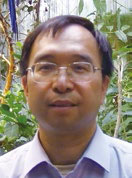Oral Presentation 3
Neuronal activation in anterior cingulate cortex correlates with motion sickness
Zhang Fuxing
The Fourth Military Medical University, Xi'an
 Zhang Fu-Xing, Ph D., Professor in Department of Human Anatomy, Histology and Embryology, The Air Force Military Medical University (the former "The Fourth Military Medical University"). Zhang Graduated from School of Life Sciences, ShaanXi Normal University in 1985, and got PhD degree from The Fourth Military Medical University in 2000. From 2001 to 2002, supported by "Dr Cheng Yu Tung Fellowships" as a research fellow, Zhang Fu-Xing worked in Professor Chan Ying Shing's lab, Department of Physiology, The University of Hong Kong; and from 2006 to 2008, as a post doctoral researcher in Department of Physiology, University of Toronto. Zhang's research interests are brain mechanisms underpinning development of pain and motion sickness. Supported by grants from National Natural Science Foundation of China, twenty-plus papers were published and four patents authorized by State Patent Office in last five years.
Zhang Fu-Xing, Ph D., Professor in Department of Human Anatomy, Histology and Embryology, The Air Force Military Medical University (the former "The Fourth Military Medical University"). Zhang Graduated from School of Life Sciences, ShaanXi Normal University in 1985, and got PhD degree from The Fourth Military Medical University in 2000. From 2001 to 2002, supported by "Dr Cheng Yu Tung Fellowships" as a research fellow, Zhang Fu-Xing worked in Professor Chan Ying Shing's lab, Department of Physiology, The University of Hong Kong; and from 2006 to 2008, as a post doctoral researcher in Department of Physiology, University of Toronto. Zhang's research interests are brain mechanisms underpinning development of pain and motion sickness. Supported by grants from National Natural Science Foundation of China, twenty-plus papers were published and four patents authorized by State Patent Office in last five years.
張富興 博士,空軍軍醫大學(原第四軍醫大學)人體解剖與組織胚胎學教研室教授。1985畢業於陝西師範大學生命科學學院獲得學士學位;2000年于第四軍醫大學獲得博士學位;2001.9 ~ 2002.9獲“鄭裕彤博士獎助金”在香港大學醫學院生理系陳應城教授實驗室工作;2006.8 ~ 2008.8多倫多大學生理系做博士後研究。科研方向:疼痛和暈動病的神經機制。主持、參加國家自然科學基金多項。近5年,發表科研論文20多篇,獲得國家專利4項。
Abstract
The anterior cingulated cortex (ACC) is a functionally heterogeneous cortical region implicated in visceral and motor modulation, as well as affect and nociception; it also plays an important role in higher brain function such as cognition involving learning, memory, attention, error-detection and decision-making etc. We investigated the functional potentiality of ACC in motion sickness via a combination of behavioral, morphological and electrophysiological approaches. Experimental animals were divided into two main groups, control and ACC-lesioned groups, and subjected to double-axis rotation for 2 hours (implemented through a self-made motor-driven instrument) depending on the particular experimental scheme. Pica, the consumption of non-food substance like kaolin, was used as an indicator of motion sickness for rat. Following rotation, rats with electrolysis of ACC showed less severe motion sickness, as indicated by less amount of kaolin intake. Morphological experiments demonstrated that double-axis rotation excited ACC neurons and induced morphological plasticity of ACC pyramidal neurons, as shown by quantitative analysis of neurons immunostained for Fos protein and spines on apical dendrites of pyramidal neurons labeled through Golgi staining. In parallel, in vitro experiments using patch clamp showed that, following rotatory stimulation, ACC neurons fired more robustly and exhibited stronger excitatory neurotransmission, as indicated by firing more action potentials upon current injection, and higher frequency and larger amplitude of spontaneous excitatory postsynaptic currents of pyramidal neurons. All the data combined suggest that ACC is activated by the prescribed stimulating paradigm which, in the present case, mainly stimulated vestibular end organs and that ACC plays a facilitating role in motion sickness.
前扣帶回皮質 (anterior cingulate cortex, ACC) 具有調節內臟和軀體運動、疼痛和情感反應、學習和記憶、認知和意識性行為(注意力控制、差錯檢測、行為選擇等)等一系列功能。我們綜合應用行為學、形態學和電生理學技術研究ACC在暈動病發生過程中的作用。大鼠分為兩大組:對照組和雙ACC損毀組。所有動物經進行雙軸旋轉運動(應用自主研發製作的電動刺激儀器刺激位置覺感受器)2小時;以異食癖(即動物食用高嶺土)為指標,評估大鼠暈動病發病情況。結果表明:電損毀ACC後,動物高嶺土食量減少,提示損毀ACC後,誘發的動物暈動病減輕。形態學研究包括:通過高爾基染色後對ACC神經元樹突棘密度分析以及免疫組織化學對Fos蛋白進行染色分析,結果表明雙軸旋轉運動使ACC神經元發生了形態學可塑性變化。此外,應用膜片鉗技術研究顯示:雙軸旋轉運動後使ACC神經元動作電位放電頻率增大、自發的興奮性突觸後電流幅值和頻率增大。這些研究結果提示雙軸旋轉運動(主要刺激前庭感受器)可啟動ACC神經元,從而易化暈動病發生。


